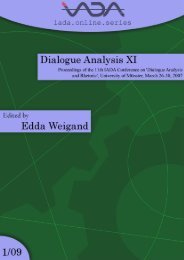Dialogue in and between Different Cultures - International ...
Dialogue in and between Different Cultures - International ...
Dialogue in and between Different Cultures - International ...
Create successful ePaper yourself
Turn your PDF publications into a flip-book with our unique Google optimized e-Paper software.
88 Anna Szczepaniak-Kozak<br />
Consequently, conduct<strong>in</strong>g a mission of any k<strong>in</strong>d, whether military or peacekeep<strong>in</strong>g,<br />
should go smoothly. So far, Pol<strong>and</strong> has implemented most of the NATO<br />
rules <strong>and</strong> is a reliable co-operant for other NATO members with<strong>in</strong> the Alliance<br />
itself <strong>and</strong> outside of NATO scope, e.g. peacekeep<strong>in</strong>g <strong>and</strong> peace restor<strong>in</strong>g missions<br />
m<strong>and</strong>ated by the United Nations.<br />
A considerable portion of our military regulations are either translations of<br />
the NATO guidel<strong>in</strong>es, which were drawn up before our accession to the Alliance,<br />
or our native written <strong>in</strong>structions which establish policies <strong>and</strong> procedures for<br />
cases <strong>in</strong> which the NATO legislative does not operate or does not exist. Ow<strong>in</strong>g to<br />
that, l<strong>in</strong>guistic comparative studies of contemporary NATO <strong>and</strong> Polish documents<br />
seem unproductive. Up to a po<strong>in</strong>t, such an analysis could be conducted to <strong>in</strong>dicate<br />
mistakes or conceptual distortions <strong>in</strong> Polish translations. To illustrate my po<strong>in</strong>t,<br />
there is a popular anecdote <strong>in</strong> the Polish Army, which says that a civilian<br />
translator who translated a document that regulates the work of civil eng<strong>in</strong>eers <strong>in</strong><br />
the military <strong>in</strong>correctly <strong>in</strong>terpreted the term civil eng<strong>in</strong>eers. The NATO document<br />
bound a unit comm<strong>and</strong>er to employ at certa<strong>in</strong> posts civil eng<strong>in</strong>eers, i.e. specialists<br />
<strong>in</strong> the art of plann<strong>in</strong>g, build<strong>in</strong>g <strong>and</strong> repair<strong>in</strong>g roads <strong>and</strong> bridges. The Polish<br />
translation of that text was to state that at those posts only civilian eng<strong>in</strong>eers<br />
might be hired, which was a clear distortion from the orig<strong>in</strong>al result<strong>in</strong>g from the<br />
erroneous <strong>in</strong>terpretation of the adjective civilian. Surely, cases of such mis<strong>in</strong>terpretations<br />
would constitute an <strong>in</strong>terest<strong>in</strong>g topic of the Polish-English contrastive<br />
translation studies. However, such an analysis is beyond the scope of the present<br />
paper.<br />
I should admit that after discover<strong>in</strong>g that contemporary Polish military<br />
regulations are mostly calques, my discursive practice research came to a st<strong>and</strong>still.<br />
However, dur<strong>in</strong>g an <strong>in</strong>terview with a Polish capta<strong>in</strong> who is a specialist <strong>in</strong><br />
military logistics, I found out that documents which were drawn up dur<strong>in</strong>g<br />
Pol<strong>and</strong>’s membership of the Warsaw Pact might offer a very <strong>in</strong>terest<strong>in</strong>g corpus to<br />
study. As a result, I decided to compare passages of the NATO regulations<br />
referr<strong>in</strong>g to logistics issues with those which discuss the same matters <strong>in</strong> the<br />
Warsaw Pact documents. The argument which supports the need for a contrastive<br />
analysis of the NATO <strong>and</strong> the Warsaw Pact logistics texts comes from the fact<br />
that <strong>in</strong> the view of the negative connotations that accompany Polish military text,<br />
they are doomed to oblivion. Even these days f<strong>in</strong>d<strong>in</strong>g a representative sample of<br />
such texts is difficult because many Warsaw Pact manuals <strong>and</strong> regulations have<br />
already been milled.<br />
I was not able to f<strong>in</strong>d an ideal counterpart to the NATO documents with<strong>in</strong> the<br />
Polish corpus. After a thorough research, I decided to compare three Polish texts<br />
<strong>and</strong> three English ones that discussed similar topics. They are as follows:<br />
− Sample 1 - fragments on load<strong>in</strong>g <strong>and</strong> unload<strong>in</strong>g of materiel com<strong>in</strong>g from the<br />
Polish logistics manual guidel<strong>in</strong>es for organization <strong>and</strong> operation of transport<br />
<strong>and</strong> material h<strong>and</strong>l<strong>in</strong>g units (1984), pages 17-24;



